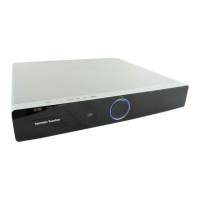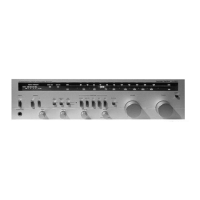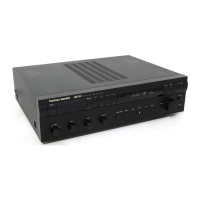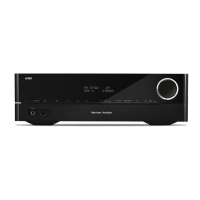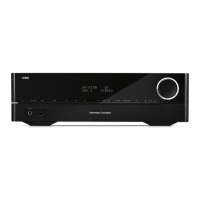REMOTE
SPEAKER
SWITCH
In
order
to
hear
all
of
the
speakers
connected
to your
remote
system,
the
respective
FRONT
and
BACK
REMOTE
speaker
switches must
be
depressed.
When
in
the
"ON"
position
the
speakers
connected
to
the
remote system
are
"ON".
Should you
desire
to listen to
stereo
or
4-CH
headphones
alone,
the
speakers
can
be
turned
off
at
your discretion.
EXT
DOLBY NR/TAPE
MON
2 SWITCH
When
an
FM
station
broadcasts
a Dolby
encoded
program,
it may
be
decoded
by use
of
an
external
Dolby processor.
If
you use
an
external
proces-
sor,
the
Dolby switch when
depressed,
will
decode
an
encoded
program.
If
the
Dolby button
is
depressed
without
an
external
processor
connected,
you
will
get
zero
output
from your
speaker
system.
Dolby
IN
receptacles
may
be
used
as
a
2-channel
Tape
Monitor
provided
you
are
not using
the
Dolby Function.
TAPE
MON
1 SWITCH
If
your 4-CH
tape
recorder
has
a
special
monitoring
feature,
depressing
this switch
"IN"
will
permit you
to
monitor your
tapes
a split
second
after
they
are
recorded.
When
not
in
use this switch must
be
in
the
"OUT"
position,
otherwise
it
will
defeat
the output
of
the
receiver.
This
switch
and
associated
rear
panel
receptacles
can
also
be
used
as
an
additional
set
of
stereo
or
4-CH high level inputs.
CONTOUR SWITCH
One
of
the
limitations
of
human
hearing
is
its
tendency
to lose sensitivity
to
the
very low pitched sounds
as
the
program
sound level
is
reduced.
It
is
this characteristic (known
as
the Fletcher-Munson effect) which
causes
one
to
play
music
programs
at
high listening levels
in
order
to
experience
the
full rich
tone
available
from fine modern recordings.
The
Harman/Kardon
CONTOUR switch
compensates
for this effect,
thereby
eliminating high listening levels
as
a requisite for full enjoyment
of
reproduced
music. For warm, full-bodied
reproduction
at
low listening levels, throw
the
CONTOUR switch to
the
IN
position. At high levels,
the
CONTOUR switch
has
no effect.
FM
MUTING
SWITCH
The
purpose
of
the muting circuit
is
to
reduce
audible
noise when tuning
from station to station. Since very
weak
signals may
be
muted
at
the
same
time,
the
front
panel
FM
MUTING switch may
be
used to
defeat
the
muting
circuit on
weak
signals.
6
To
reduce
interstation noise, push
the
MUTING switch
"ON".
To
defeat
the
circuit, push
the
switch
"OFF".
To
adjust
muting levels
see
MUTING
ADJUSTMENT
CONTROL.
HIGH CUT SWITCH
The HIGH
CUT
filter
has
been
designed
to
reduce
the
high
frequency
response
of
your receiver.
This
will
reduce
arinoying
record
scratch,
tape
hiss,
FM
background
noise, etc.
LOW
CUT
SWITCH
At times,
record
changers,
turntables
and
even
some
FM
stations
produce
an
objectionable
low
frequency
signal
that
is
strong
enough
to
be
introduced
into
the
playback
system.
This
is
known
as
rumble
and
can
be
cancelled
out by
the
special
low
frequency
cut off filter network included
in
this receiver.
When-
ever
rumble
is
present
depress
the
LOW
CUT
switch.
FUNCTION SWITCH
This
switch selects
the
desired
program
source to
be
heard
through your
music system.
PHONO 1/PHONO 2
Use
these
positions for all mono,
stereo
or
SQ
matrix records.
Any
standard
stereo
record
player
can
play
SQ
matrix discs without
special
modifications. The
SQ
disc
is
completely
compatible
with
stereo
systems
and
can
be
played
on
any
quality
record
changer
or
manual
turntable
using a high
compliance
magnetic
pickup.
Your existing
record
player
connected
to
the
LEFT
and
RIGHT,
PHONO 1
or
PHONO 2 input
receptacles
will
play
your mono,
stereo
and
SQ
records.
In
order
to
play
SQ
discs
in
4-CH
the
mode
switch should
be
placed
in
either
the
SQ
matrix 1
or
SQ
matrix 2 positions.
STEREO
FM
This
is
the
normal listening position for all monophonic
or
stereophonic
FM
broadcasts.
In
this position
the
stereo
indicator
light
and
automatic
switch-
ing circuit built ino your receiver
are
operative.
For further
details
refer
to
paragraph
on "SELECTING MONOPHONIC OR
FM
STEREO
BROADCAST".
Should you receive a
weak
stereo
signal
whose
quality
has
been
degraded
by noise
or
poor
signal conditions,
and
you wish to listen to this
stereo
broad-
cast
monophonically, switch to
the
FM
position.
FM
In
this position you
can
listen to
stereophonic
broadcasts
monophonically
while monophonic
broadcasts
will
appear
unchanged.
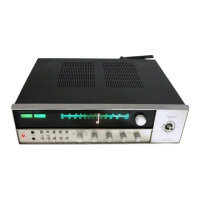
